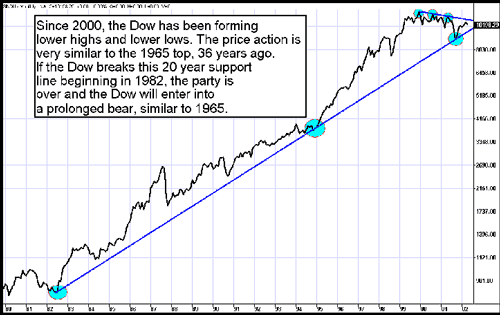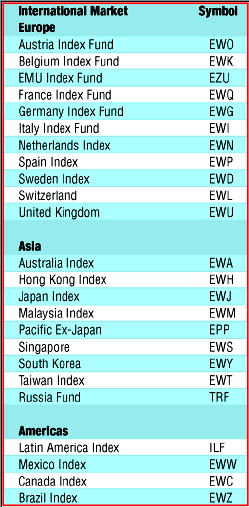
HOT TOPICS LIST
- Strategies
- Stocks
- Buy
- Investing
- Brokers
- Psychology
- Interviews
- Accumulate
- Sell
- Hold
- Spotlight
- Websites
- Candlestick Corner
- Gold & Metals
- Options Trading
LIST OF TOPICS
TRADER'S NOTEBOOK
Should Investing Increase Your Capital Or Protect It?
05/07/02 03:10:09 PM PSTby Omar Bassal
Preserving capital in today's markets brings up questions you may not have considered.
| What is the most important goal of investing? This question is not as simple as it seems; more often than not, investors' initial responses to it highlight why so many fail to generate market-beating returns. The most common answer you're likely to receive to this question is: "Capital appreciation, of course! How difficult can that be to understand? You invest to earn a return on your money in excess of the risk-free rate, and if you're investing in stocks that are as risky as the general market, hopefully your returns are in excess of the average returns of the Standard & Poor's 500." Wrong answer. The most important goal of investing is capital preservation. While this is a subtle distinction, you can never get to the second objective of investing — appreciation — if proper precautions are not taken to preserve capital in the first place. Too many investors spend inordinate amounts of time seeking market-beating returns without imposing strict money management policies that would ensure the survival of their portfolio. As a result, they eventually lose their money. Capital preservation is more important today than ever before. When the US equity markets were in their heyday of the 1990s, few worried about preserving their money. As the market adage says, a bull market makes everyone look smart. Many of the "CNBC Generation" believed that the stock market was only going one way, and that was up. Risk control measures interfered with riding the next inevitable wave. The old paradigm was dead, a common argument went, and a new one was emerging. There was even a 1999 Fortune article that quoted an analyst from a reputable firm who remarked, "Any time in between 9:30 am and 4:00 pm is a good time to buy Microsoft." Insanity? It wasn't at the time. That analyst's thoughts reflected a conditioning that many were exposed to as stocks time and again seemed to end their runs, only to break out and climb higher, delivering returns in excess of 100% in the course of a few months. Reality set in when suddenly the music of the market stopped, and thousands of investors rushed to sit in a few hundred chairs representing profit. What lessons did we learn from that time that could help investors today? One fundamental lesson is that markets change, but investors don't. I am a big proponent of technical analysis, the study of prices and volume to determine the likely future direction of prices. What I have come to respect about technical analysis that fundamental analysis lacks is its incorporation of the rational and irrational behavior of market participants. Performing a discounted cash flow analysis of your favorite company might give you the value the company's equity shares should be trading at, but it will not give you any information about how other market participants feel about the company, nor does it incorporate their irrational behavior. So in an environment like the late 1990s, valuation models existed almost in a vacuum because they failed to incorporate the mindset of traders. Models were revised to try to reconcile an analyst's $30 per share valuation to the market's $100 per share price. The exercise was fruitless, because those new models had to be trashed after the bubble burst: Investors remembered that technology will not solve the world's ills, nor can a company lose money on each sale but "make it up in volume." I bring up the issue of incorporating irrationality into investment decisions because of its applicability to today's market environment. Investors need to realize that preserving their money should be their top priority, rather than appreciation. Many market pundits argue that long-term investing is the only way to go. Based on history, it's difficult to argue against such a premise. But I am going to try.
WHY CAPITAL PRESERVATION?Over the past 200 years, US equities no doubt have been the place your money should have been invested. However, nobody lives for 200 years, so traders must be prepared for the ups and downs that come with investing. There were several periods during those 200 years when the US equity market returned nothing over the course of 10 or 15 years. Consider December 31, 1965. The Dow Jones Industrial Average (DJIA) on that day closed at 1000 for the first time in its history. Impressive, right? Not exactly. The DJIA did not break through that 1000 peak until October 18, 1982. The market oscillated between 530 and 1000 for nearly 17 years. The level was so notoriously difficult to break through that fund managers referred to it as a "graveyard in the sky." Few of us can afford to wait out the recovery of an investment over that many years. If you were alive in 1965 and had incredible foresight, "long-term investing" would not have been your method, unless you were willing to achieve a fabulous 0% return over 17 years (which actually falls into the negative when adjusted for the high inflation rate during that period). Another example is June 28, 1929. The DJIA hit an all-time high of 400 — and did not break through 400 again until December 29, 1954. Imagine buying the DJIA on June 28, 1929, and having to wait 25 years simply to break even. It's not just the DJIA, either; broadening your analysis to international indexes such as Japan will show similar scenarios. If there's one lesson to be learned from history, it's that long-term investing is not always right — it's only right at the beginning of a bull market. My belief is that March 10, 2000, will be followed by the same kind of market action as June 28, 1929, and December 31, 1965. If you believe in market cycles, the timing of the 2000 top adds support to this belief — that is, approximately 36 years separate the 1929 top from the 1965 top, and the 1965 top from the 2000 top. Finally, and as the chart in Figure 1 shows, the Dow Jones Industrial Average is close to breaking a 20-year support line. This support line measures the rate of appreciation the DJIA has achieved since the secular bull market began in 1982. Since the top in 2000, the DJIA has consistently made lower highs and lower lows, a sign that sellers are firmly in control — despite what you might hear on CNBC or read that reports that the rally is coming soon. Once the DJIA pierces the support line shown, the prolonged bull market that began in 1982 will officially be over and the start of a rough period will begin, similar to what was seen in 1965.
Figure 1: Dow Jones Industrial Average. From this chart you can see that the DJIA is close to breaking its 20-year trendline. Investment advisors and market pundits may say that "now" is different from "then." Similar arguments were made about why things were different with the "Old Economy" and "New Economy" stocks back in the 1990s. You don't hear those terms anymore, do you? The proponents of investing for the long term "no matter what" usually have a conflict of interest, because they are the very ones who benefit from the status quo. Fund managers and analysts who want investors to keep their money in the US equity markets naturally want investors to "invest for the long term," since their assets generate lucrative management fees. You will never hear a fund manager or analyst working for an investment bank advocating anything except what is in the interests of his/her firm.
WHAT ARE YOUR OPTIONS?There are two solutions to the severe risk of a likely prolonged downturn facing US investors today: alternative investment methods and international diversification. Alterative investment methods include hedge funds, commodity trading consultation, and managed futures. Hedge funds are the fastest-growing segment in the investment management industry, and many are focused on achieving "absolute-oriented returns," which are returns independent of market performance. This means that even if the DJIA and Nasdaq enter into a prolonged downturn, absolute-oriented returns hedge funds can continue achieving 15% to 20% annually. In fact, a 10-year study performed by Lehman Brothers and the SAIS Group of Switzerland revealed that equity hedge funds produced average annual returns of 20.22% with a standard deviation of 9.29%, versus the S&P 500's 9.73% annual returns with a standard deviation of 14.54%. International diversification is another option that investors should consider. Several international markets such as China, Malaysia, Russia, Indonesia, and Singapore have low correlations to the US equity markets and can achieve healthy returns while the US market is oscillating. Not only that, investing in them today is easier than ever. There are now dozens of exchange-traded funds* and iShares traded on the US equity markets (Figure 2) that allow investors to buy and sell shares representing international indexes and funds. These investment vehicles offer the benefits of international diversification at reduced costs and risk. A listing of the symbols of a few international indexes traded on the US equity markets is included here. Malaysia may be the most attractive today.
Figure 2: There are several exchange-traded funds and iShares that represent different countries.
Capital preservation should be the hallmark of all investors' trading styles. Based on market valuations, earnings, and history, there is a significant risk that the US equity markets will offer few opportunities to generate double-digit annual returns in the coming years. Investors should look instead to international indexes and alterative investments to grow their portfolios.
Omar Bassal is co-founder of The Sidrah Group, an ethically conscious company seeking superior absolute-oriented returns. He has an MBA from the Wharton School of the University of Pennsylvania and is an affiliate member of the Market Technicians Association. He has breathed, dreamed, and lived stocks since he first began trading in the early 1990s. He can be reached via e-mail at bassalo@wharton.upenn.edu. TradeStation (TradeStation Technologies)
Current and past articles from Working Money, The Investors' Magazine, can be found at Working-Money.com. * See our cumulative online glossary. |
MBA student at the Wharton School of the University of Pennsylvania and an affiliate member of the Market Technicians Association.
| Address: | 3900 Chestnut ST APT 926 |
| Philadelphia, PA 19104 | |
| E-mail address: | bassalo@wharton.upenn.edu |
PRINT THIS ARTICLE

|

Request Information From Our Sponsors
- StockCharts.com, Inc.
- Candle Patterns
- Candlestick Charting Explained
- Intermarket Technical Analysis
- John Murphy on Chart Analysis
- John Murphy's Chart Pattern Recognition
- John Murphy's Market Message
- MurphyExplainsMarketAnalysis-Intermarket Analysis
- MurphyExplainsMarketAnalysis-Visual Analysis
- StockCharts.com
- Technical Analysis of the Financial Markets
- The Visual Investor
- VectorVest, Inc.
- Executive Premier Workshop
- One-Day Options Course
- OptionsPro
- Retirement Income Workshop
- Sure-Fire Trading Systems (VectorVest, Inc.)
- Trading as a Business Workshop
- VectorVest 7 EOD
- VectorVest 7 RealTime/IntraDay
- VectorVest AutoTester
- VectorVest Educational Services
- VectorVest OnLine
- VectorVest Options Analyzer
- VectorVest ProGraphics v6.0
- VectorVest ProTrader 7
- VectorVest RealTime Derby Tool
- VectorVest Simulator
- VectorVest Variator
- VectorVest Watchdog


